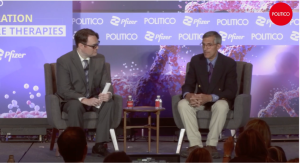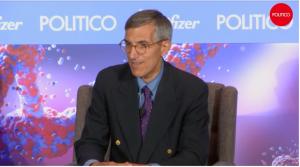In a wide-ranging interview with POLITICO reporter Robert King at the Next Generation of Health Care Therapies event, Dr. Peter Marks, Director, Center for Biologics Evaluation and Research (CBER) at the U.S. Food and Drug Administration (FDA), discussed cell and gene therapies (CGT) and the role regulatory streamlining and Artificial Intelligence (AI) are both likely to play in the future.
Robert King kicked off the conversation by referencing the cell and gene therapy industry’s recent successes, with five regulatory approvals secured by therapeutics developers in 2022, and three so far this year, setting the stage to explore how these technologies can be better supported and more efficiently processed as the industry matures. Here are the five main takeaways.
- There are opportunities to make therapies more commercially viable
By focusing on shared characteristics, developmental efficiencies can be unlocked. “There are a number of things, some of this is about brute force manufacturing,” explained Dr. Marks. “We need to retool and develop more automation in the production, particularly of small batch gene therapy. Some of it is also about taking advantage of some of the properties that gene therapies have, [such as current] viral vector gene therapies, which all have a backbone and, in many cases, it’s the same backbone that’s being reused.”
- The FDA is working to reduce regulatory burden
Building on the observation that some therapeutics share and reuse figurative backbones, Dr. Marks explained that the FDA is hoping that the platform technologies provision, included as part of the FDA reform act of 2022, will apply to some gene therapies and help their developers. The provision requires the FDA to create a designation program for technologies that have the potential to be incorporated into, or used by, more than one drug or biological product.
“The idea [with the provision] being that if we can reduce some of the regulatory burden in terms of submission, we can hopefully make it easier to have throughput of many different gene therapies because there are hundreds of diseases that could potentially be addressed, but if we have to treat each one from scratch, it may take a very long time to get there, so we’re trying to make the process more efficient.” (Ed: For more on reducing the regulatory burden and being more efficient to accelerate treatments to the public sphere, read about a bespoke gene therapy consortium launched by the Foundation for the National Institutes of Health.)
- Progress will revive venture capital interest
Signals has featured commentary on the ongoing “biotech winter,” previously. Having lived through several investment deep-freezes, Keith Thompson, CBE, Chairman of NK:IO, and advisor to Deep Science Ventures, was keen to remind us that they do eventually come to an end, and that the thawing of 2012’s investment winter was triggered by “new and outstanding clinical results with new technologies and new indications.” He noted that although many investors are focused on their existing portfolios right now, another wave of positive results would likely unlock the “investment freezer.”
Dr. Marks appears to agree. “I think we’re all too aware that venture capital has found gene therapy a little disappointing and has pulled back somewhat,” explained Dr. Marks. “I think part of the way of trying to get people interested in [it] again, is to try to help […] streamline and move things forward – always with the mind that we’re going to make sure the products are high quality, safe and effective – but if we can get there using accelerated approvals, ultimately we do benefit patients by having those products be able to help people sooner.”
- We all have an eye on AI, and it’s already proving useful at the FDA
AI has some industries more on edge than others, but the FDA is embracing it. “So as opposed to people in Hollywood who really hate AI, AI for us could potentially be a real game changer,” observed Dr. Marks. “In manufacturing, particularly in production of complex biologic products, it has the potential for helping us to control so many different variables that previously we couldn’t, because it can continually sense, and you can serve it up a lot of data. It can look at 50 different parameters in a way that a human can’t, and can figure out which ones can be optimized. So, we’re hoping that AI allows us to improve the efficiency of manufacturing.”
“We have a very active group working with AI. So far. We’ve used it a fair amount on the pharmacovigilance side of things looking at safety and, also, in the analysis of data that has [sic] come in, in terms of whole genome sequencing data that comes [sic] in with certain applications. What I can say is we will continue to explore this. We’re trying to keep up with AI as much as everyone else because it’s over the past year or two it’s really blossomed very rapidly.”
You can see a clip of Dr. Marks’s comments regarding AI on the Politico website.
- Work is ongoing to build on the success of Operation Warp Speed
Constant communication between the FDA and vaccine developers enabled a faster response to the pandemic. Now, a pilot program is set to facilitate a similarly speedy line of communication between the FDA and therapeutics developers targeting rare diseases with high unmet clinical need. “One of the things we learnt from Operation Warp Speed is that communication with the agency can really speed up development…” commented Dr. Marks, “we ended up running the dry cleaners of [the] regulatory world. We had questions come in at 9 a.m. and we made sure that we got responses out by 5 or 6 p.m.”
“We will be launching a pilot. It’ll be a small pilot, because it’s very resource intensive, for rare diseases with high unmet medical need this fall, to see if that same type of attention will make a difference.” You can read more about the upcoming pilot program in BioSpace.
Unlocking the potential of CGTs was a thread running through Politico’s keynote interview with Dr. Marks. Though many of the manufacturing challenges on the road ahead lay with CGT developers – and contract development and manufacturing organizations that have been established to support them – it’s good to know that the FDA is clearly committed to playing its part by driving efficiencies that reduce regulatory burdens, embracing new AI technologies and building upon the successes of Operation Warp Speed. Ensuring the commercial viability of CGTs in the years ahead will require this kind of joined-up forward thinking from key stakeholders across the private and public sector.
Cal Strode
Latest posts by Cal Strode (see all)
- World AIDS Day: Update on HIV cure research and gene therapies - December 1, 2025
- Headwinds and tailwinds for cell and gene therapy under the second Trump administration - March 11, 2025
- From innovation to international impact: ARM’s 2025 “State of the Industry Briefing” showcases maturing CGT industry - January 20, 2025








Comments